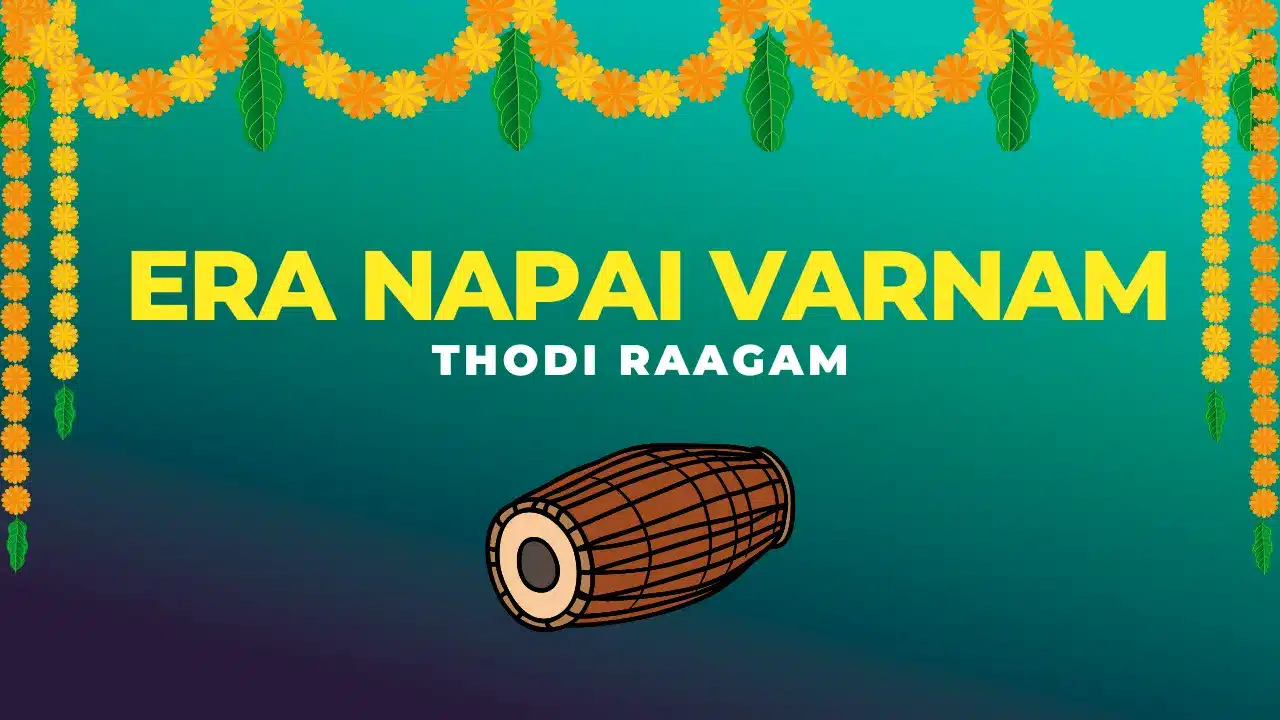Introduction
If you want to sing a magnificent Raagam, look no further. Thodi is your answer. This blog is about Era Napai varnam and the Raagam, Thodi.
This Raagam has the capability of stirring your soul. The reason for the Raagam to be this prominent is that, this has been a constant in concerts from time immemorial. The smaller variants of all the notes, creates a hyperbole that cannot be denied, and this is the reason for the Raagam to be a magnificent one. Thodi is not a peppy raagam and it has a steady and patient pace.

If you just keep calling her to come, will Thodi come?
Thodi comes at the number 8 in the list of Melakartha raagams. It goes by another name “Hanumathodi”. According to the Kattayapadi formula, the syllables Ha and Nu have a special significance in the Raagam. Kattayapadi formula is where a raagam forms from the first two syllables of the Raagam’s name. IN this case, Ha and Nu from Hanumathodi.
Aro: Sa Ri Ga Ma Pa Da Ni Ṡa
Ava: Ṡa Ni Da Pa Ma Ga Ri Sa
Era Napai is a varnam that is taught, only when the student reaches a level of proficiency in Carnatic Music. It is because this Raagam and this Varnam cant be sung with flat notes. This is considered to be one of the difficult Raagams in carnatic music. Flat rendition of Era Napai Varnam will create a tone that is no where near the original tone of the Raagam.
Significance of Thodi
The Raagam that follows Thodi in the Melakartha list, Dhenuka, is completely different from Thodi and that is the beauty of Carnatic Music. Thodi has all the shakes, called Gamakas and slides humanly possible, a few out of the world as well. Whereas Dhenuka does not have the shakes and the glides. The composition Theliyeledhu Rama set in Dhenuka, is probably the only composition which is very similar to Thodi and if rendered back to back in a concert, the audience may think that the artist has a favourite Raagam.
An old tamil proverb, signifies the difficulty behind mastering Raagam Thodi. This proverb is, hands down, quoted by all the Carnatic Teachers, when they visit the Raagam. The proverb goes like “Vaa di, vaadinna varuma Thodi?”. The literal translation is that just because you repeatedly keep on calling, will Thodi come to you. The amount of dedication that a student has also adds on to the talent of the student and this comes in hand while mastering Thodi.
Era Napai Varnam
There are many popular compositions of Thodi that are repeatedly heard in concerts. Era Napai Varnam is one such Varnam. It is usually preferred by the musicians to start the Concert with Era Napai varnam. This does indeed grab away the chance of being the central piece in a concert, for the Raagam. A central piece in a concert is the Raagam that the musician chooses and it gets more time allotted in the whole of the concert. But a great deal of the listeners and rasikas, love hearing Era Napai varnam in the start, as it is the best classical start for them.
One point to note is that the musician does not end the Varnam just with how the notes and notations go. They can choose to add an aalapanai, a raagam brief before the Varnam. They will also add a few subsequent swara combinations of the Raagam, when they sing the Chittai Swaras. With this a solid fifteen minutes of Era Napai varnam rendition is possible.
Lets see the notes and notations of Era Napai.

Did You Know?
Thodi is generally used to sing the emotion Karuna and Bhakthi.
Varnam: Era napai inta
Raga: Todi
Tala: Adi
Composer : Patnam Subramanya Iyer
Aro: S R1 G2 M1 P D1 N2 Ṡ
Ava: Ṡ N2 D1 P M1 G2 R1 S
Pallavi
| Ṡ | , | ,- | Ṡ | N | D | P | D | N | N | D | P | M | G | M | N | | | |||
| E | – | – | ra | – | – | na | – | – | pai | – | – | – | – | – | inta | | | |||
| N | D | P | M | G | R | S | R | | | G | M | P | G | M | P | D | N | || | ||
| Chou | – | – | ka | – | – | se | – | | | – | – | – | ya | – | – | – | – | || | ||
| Ṡ | R | Ġ | N | Ṡ | Ṙ | D | N | D | Ġ | Ṙ | Ṡ | N | D | P | M | | | |||
| me | – | – | ra | – | – | ga | – | – | du | – | – | ra | – | – | – | | | |||
| D | , | , | , | , | ,- | Ṡ | N | | | D | P | M | G | M | P | D | N | || | ||
| na | – | – | – | – | – | sa | – | | | – | – | – | mi | – | – | – | – | || |
Anupallavi
| N | D | D | N | D | D | N | G | M | N | D | P | M | G | R | S | | | |||
| Ma | – | – | – | ru | – | – | ni | – | kan | – | – | na | – | – | – | | | |||
| M | G | M | P | D | N | Ṡ | N | | | D | P | D | N | Ṡ | ,- | D | P | || | ||
| Shri | – | – | Ven | – | – | ka | – | | | te | – | – | – | sha | – | su | ku | || | ||
| D | N | Ṡ | Ṙ | Ġ | Ṙ | Ġ | Ṁ | Ġ | Ṙ | N | Ġ | Ṙ | Ṡ | N | D | | | |||
| ma | – | – | – | ra | – | nan | – | – | – | ne | – | – | – | lu | – | | | |||
| N | Ṡ | Ṙ | D | N | D | Ġ | Ṙ | | | Ṡ | N | D | P | M | P | D | N | || | ||
| Ko | – | – | ra | – | – | sa | – | | | ra | – | su | – | – | da | – | – | || |
Muktayi Swaram
| Ṡ | Ṙ | Ṡ | N | D | N | Ṡ | , | N | Ṙ | N | D | P | M | G | M | | | |||
| P | D | N | D | N | Ṡ | N | D | | | N | Ṡ | N | Ṙ | Ṡ | , | , | , | || | ||
| D | N | D | Ġ | Ṙ | Ṙ | Ṁ | Ġ | Ṙ | Ṡ | N | Ġ | Ṙ | Ṡ | N | D | | | |||
| N | Ġ | Ṙ | N | Ṙ | N | D | N | | | D | Ġ | Ṙ | N | D | M | D | N | || |
Charanam
| D | , | ,- | N | Ṙ | Ṡ | Ṡ | N | N | D | P | M | G | R | S | R | | | |||
| Da | – | – | ni | ma | – | – | – | ta | – | – | lu | – | vi | ni | – | || | |||
| G | , | ,- | M | , | ,- | P | D | | | N | Ṡ | ,- | Ṡ | N | D | P | M | | | ||
| in | – | – | ta | – | – | sa | – | | | ha | sa | – | me | – | la | – | ra | || |
Chittai Swaram 1
| 1 | G | , | ,- | M | , | ,- | G | , | , | , | R | , | Ṇ | , | R | , | | | |||
| S | , | ,- | Ḍ | , | ,- | Ṇ | , | | | ,- | Ṡ | , | R | , | G | , | M | || |
Chittai Swaram 2
| 2 | D | , | N | D | D | M | G | M | D | , | M | G | , | R | S | Ṇ | | | |||
| S | , | R | G | ,- | M | D | N | | | Ṡ | N | ,- | D | , | M | G | M | || |
Chittai Swaram 3
| 3 | M | D | N | Ṡ | , | N | D | N | Ṡ | N | ,- | D | R | Ṡ | N | D | | | |||
| D | , | M | G | , | M | N | D | | | M | D | N | Ṡ | D | , | – | N | | | |||
| D | M | G | R | S | D | M | G | R | S | R | G | M | D | N | Ṡ | | | ||||
| Ṙ | Ġ | Ṙ | , | N | D | Ṇ | D | | | M | G | R- | Ṇ | S | R | G | M | | |
Chittai Swaram 4
| 4 | D | N | D | P | G | M | N | D | M | G | R | S | D | M | G | R | | | |||
| S | G | R | Ṇ | Ḍ | Ṇ | R | Ṇ | | | Ḍ | Ṇ | S | R | G | M | D | M | || | |||
| D | N | Ṡ | Ṙ | N | D | N | Ṡ | Ṙ | Ġ | Ṙ | N | D | N | D | M | | | ||||
| G | R | Ṡ | Ġ | Ṙ | N | D | M | | | G | R | S | Ṇ | S | R | G | M | || |
Chittai Swaram 5
| 5 | Ṡ | , | ,- | N | D | N | Ṡ | , | , | N | D | N | N | , | , | D | | | |||
| M | D | N | D | ,- | Ṙ | Ṡ | N | | | D | , | M | G | , | M | D | N | || | |||
| Ṙ | N | D | M | G | R | N | D | M | G | R | D | M | G | R | S | | | ||||
| Ṇ | S | R | G | M | D | S | R | | | G | M | D | M | D | N | Ṡ | Ṙ | || | |||
| Ṡ | Ṙ | Ġ | Ṙ | , | N | D | N | Ġ | Ṙ | , | N | D | N | Ṙ | N | | | ||||
| , | D | M | D | N | Ṡ | , | N | | | D | M | ,- | G | M | D | D | N | || | |||
| Ṡ | Ṙ | Ġ | N | Ṡ | Ṙ | D | N | Ṡ | M | D | N | G | M | D | N | | | ||||
| Ṡ | Ṙ | Ġ | Ṁ | Ġ | Ṙ | N | D | | | M | G | R | Ṇ | S | R | G | M | || |
FAQs
What is the Aarohanam and Avarohanam of Thodi?
Aro: Sa Ri Ga Ma Pa Da Ni Ṡa
Ava: Ṡa Ni Da Pa Ma Ga Ri Sa
When is Era Napai generally sung?
This is sung in the beginning of the concert, and a solid 15 minutes of the rendition is heard usually.
Who composed Era Napai?
Pattnam Subramaniya Iyer is the composer of Era Napai.
What is the other name for Thodi?
The other name for Thodi is Hanumathodi.
Related blog: Sarasuda Ninne Varnam































